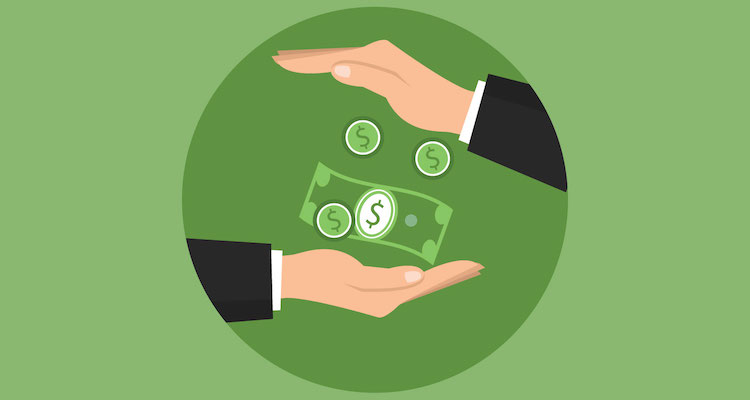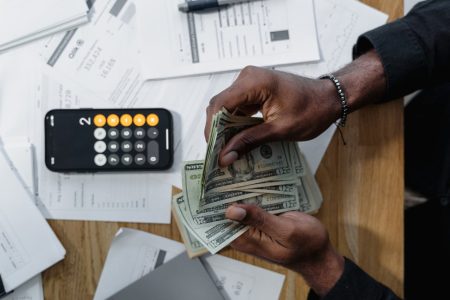When you have a regular day job, you get paid on a predictable schedule. Getting paid twice every month means your income is typically around the same amount when they arrive, and it shows up magically in your bank account via direct deposit on a regular cadence. This means planning to pay your bills is easy.
When I still had day job income, I paid my credit cards every other week on payday and paid my mortgage on the last payday of the month. This made managing my personal cash flow easy and predictable. Any side hustle income was just gravy on top! But now that my side hustle has become my day job, my cash flow works a little differently. Here is what I’ve learned along the way.
Table of Contents
ToggleSave and build revenue until you can pay yourself a paycheck
My first step in getting more normalized revenue was to avoid paying myself. I took the minimum cash from the business I could to pay for my family’s basic living expenses in the first few months I had the business until it had grown enough to start paying myself a regular, weekly paycheck.
When I moved from Portland to Southern California last year, I converted the business from an LLC to an S-Corp. There are some big tax benefits of S-Corps for businesses that make over around $40,000 per year, and it was clear from my prior year side hustle income of $40,000 that I would be doing more than that the first year I took the business full-time.
As an LLC, you have to pay self-employment tax on every dollar you earn. As an S-Corp, you only have to pay self-employment tax on your paycheck, which has to be a “reasonable salary” for your position according to IRS rules. I pay myself $35,000 per year, a reasonable salary for someone working as a full-time writer, divided over 52 weekly paychecks.
Knowing that I will get a check for $587 every Friday (after tax, I use Gusto as a payroll service) makes it easier to manage my monthly bills. It is hard to get predictability in self-employment, but this step helps smooth out my personal income.
Give yourself a small paycheck with monthly “dividends”
If you read my blog, you know I make a heck of a lot more than $35,000 per year in online revenue. After taking out my paycheck, taxes, and other business expenses, the business earns a nice profit every month. Even after my paycheck, the business often has at least a few thousand dollars in cash sitting in the bank.
The business pays me this cash in the form of dividends, which are just online banking transfers from my business checking account at Chase to my personal checking account at Charles Schwab.
These dividends are actually worth more than my paychecks! It’s nice being a business owner where the “employee” (that’s me) does the hard work for $35,000 per year while the owner (also me) gets to keep the profits!
Dividend payments are not on the same regular schedule as paychecks, which have to follow certain Federal and state regulations. My dividends are typically more of an “as needed” payment. My paychecks cover my rent but not much more, I live in Southern California after all, so the dividends make up the difference in my monthly living expenses to ensure we have enough cash in the bank to pay off the credit cards and other bills in full every month.
Build up a sizable business and personal savings
I only pay myself what I need to live, which means if the business earns more than my expenses, which it does every month, the business should end the month with more in cash in the bank than the start of the month. If your business doesn’t earn enough each month to cover you necessities, it is probably better as a side hustle than a full-time gig, or you need to do something to fix your business and earn more, or cut your expenses.
Because of the way LLCs and S-Corps are taxed, it doesn’t matter if the income sits in the business bank or the personal account, so last year when taxes were due it was nice to have that extra cushion in my business account. Last month, I took two weeks for work and vacation trips. It was nice knowing that even if I earned zero dollars in May, I have enough cash in the bank to cover my paycheck and other expenses for a month without blinking an eye.
Everyone should have an emergency fund that covers three to six months of expenses if they have a day job and steady income. Self-employed entrepreneurs should double that. Save three to six months of expenses in a personal emergency fund plus another three to six months of expenses in your business account as an absolute minimum. My long-term plan is for the business to have an entire year of expenses saved up plus at least that much in personal savings.
Make an annual plan and review your finances monthly
Solo entrepreneurs, small business owners, and startup founders typically don’t have a team of full-time finance and accounting professionals monitoring their money every day. That falls on your shoulders. So make sure to review your finances annually and monthly.
Every year at the start of the year, create a basic budget that outlines your expected revenue and expenses each month for the year. You know it won’t be exactly right, but it can act as a good guideline to follow. Make small adjustments and check in monthly to ensure you are on track and make changes as necessary if your revenue is too low or expenses too high to meet your business and personal needs.
You’re the boss, enjoy it!
One of the biggest benefits of self-employment is the freedom to adjust your schedule and be flexible as you want, or need. If money isn’t coming in, cut back on expenses and go on a ramen diet for a few weeks. If money is flush, save up during the good times to weather the bad.
Self-employment is an amazing lifestyle. As long as you have the finances and operations under control, you can relax and focus on the parts of your business you enjoy most. You’re the boss, enjoy it!
















